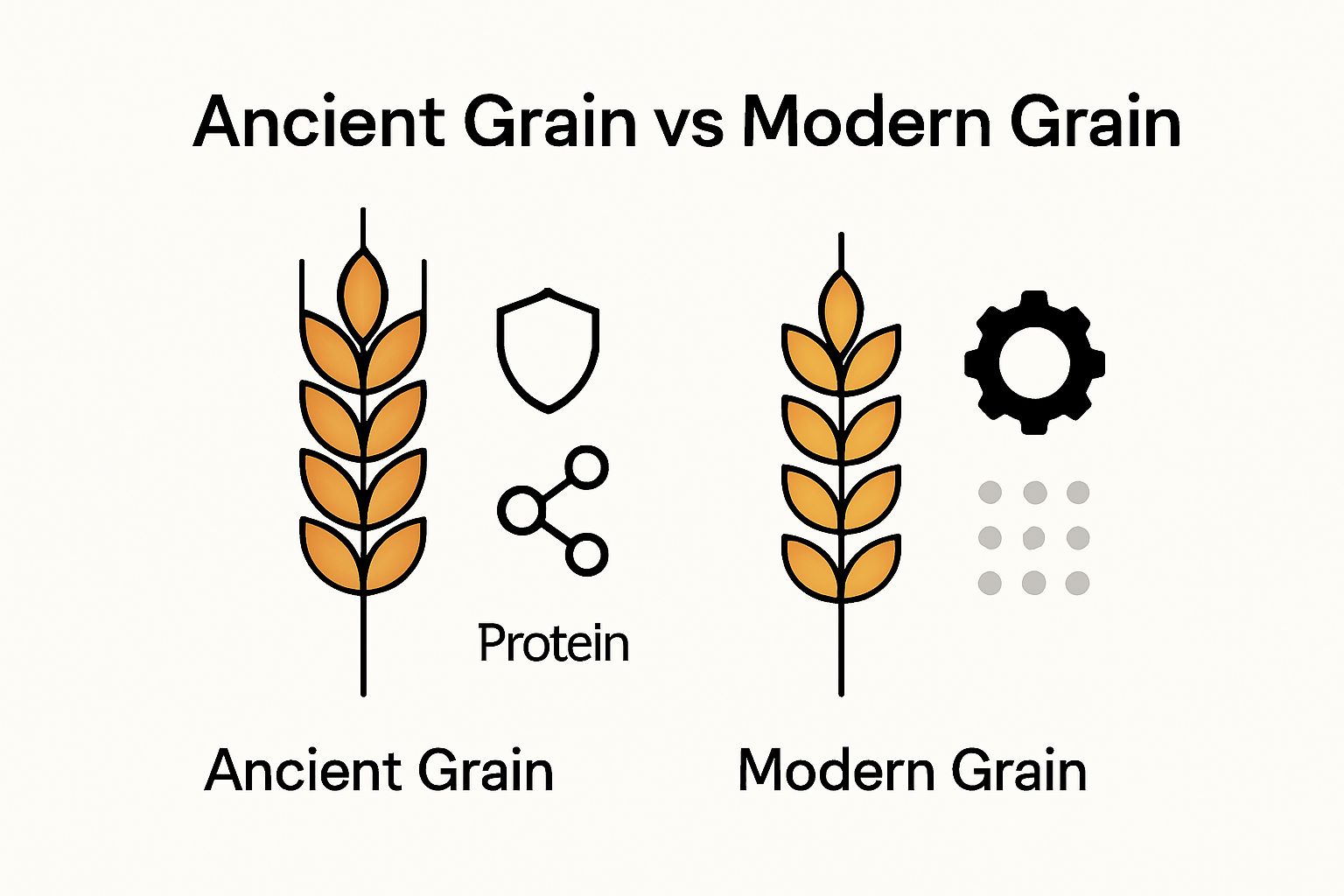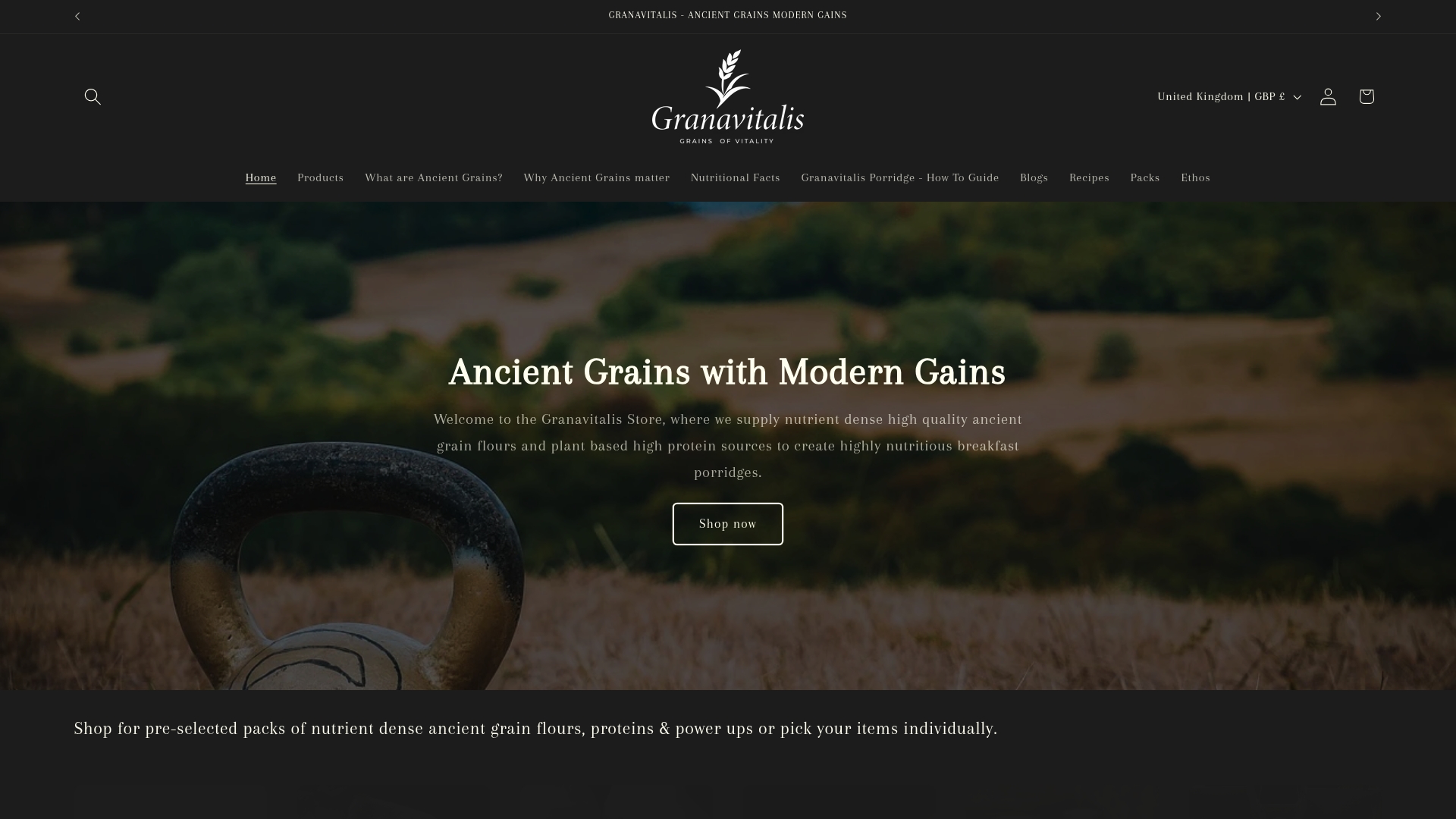
Understanding Gluten-Free Ancient Grains Guide
Share
Gluten-free ancient grains have been fuelling whole civilisations for thousands of years and are making a strong comeback in modern diets. Most people think gluten-free options usually mean nutritional sacrifice or bland taste but that is not the case here. Some of these powerhouse grains like quinoa actually contain all nine essential amino acids which means you get complete protein from a single plant source.
Table of Contents
- What Are Gluten-Free Ancient Grains and Their Origins?
- Why Gluten-Free Ancient Grains Matter for Health
- How Gluten-Free Ancient Grains Contribute to Nutrition
- Key Differences Between Ancient Grains and Modern Grains
- Exploring Culinary Uses and Applications of Ancient Grains
Quick Summary
| Takeaway | Explanation |
|---|---|
| Ancient grains are gluten-free | They provide a nutritious alternative for people with coeliac disease or gluten sensitivity. |
| High nutritional density benefits health | Quinoa, amaranth, and teff offer vital proteins, minerals, and antioxidants that support overall wellness. |
| Support sustained energy and digestion | Ancient grains release energy slowly, helping to prevent blood sugar spikes while promoting digestive health. |
| Minimal genetic modification ensures purity | Unlike modern grains, ancient varieties maintain their original genetic structure, preserving their nutritional integrity. |
| Versatile culinary applications enhance meals | Ancient grains can be prepared in diverse ways, integrating easily into a variety of dietary preferences. |
What Are Gluten-Free Ancient Grains and Their Origins?
Gluten-free ancient grains represent a remarkable category of nutritional powerhouses that have sustained human populations for thousands of years before modern agricultural practices. These remarkable foods are naturally free from gluten protein, making them an exceptional alternative for individuals with coeliac disease, gluten sensitivity, or those seeking more diverse nutritional profiles.
Origins and Cultural Significance
Ancient grains trace their roots across diverse global regions, each carrying unique evolutionary adaptations and cultural histories. Research from the National Institutes of Health highlights that civilisations like the Aztecs and Incas cultivated quinoa and amaranth in South America, while African and Asian cultures developed millet and teff as staple crops. These grains survived in challenging environmental conditions, developing robust nutritional characteristics that modern wheat varieties often lack.
Key characteristics of these extraordinary grains include:
- Genetic Purity: Minimal genetic modification compared to contemporary wheat strains
- Nutritional Density: Higher protein, mineral, and micronutrient concentrations
- Environmental Resilience: Ability to grow in challenging agricultural landscapes
Nutritional Profiles and Modern Relevance
Gluten-free ancient grains offer significantly more than just dietary alternatives. They represent complex nutritional ecosystems that have supported human health for millennia. Quinoa, for instance, contains all nine essential amino acids, making it a complete protein source. Amaranth provides remarkable calcium and magnesium levels, while teff offers exceptional iron content.
By understanding ancient grains and their potential, modern consumers can reconnect with traditional nutritional wisdom. These grains are not merely food but represent a bridge between historical agricultural practices and contemporary nutritional science.
Why Gluten-Free Ancient Grains Matter for Health
Gluten-free ancient grains are not merely dietary alternatives but powerful nutritional solutions that contribute significantly to overall wellness. Their exceptional health benefits stem from unique molecular compositions that differ substantially from contemporary processed grains, offering profound advantages for human nutrition.
Nutritional Superiority and Metabolic Benefits
Research from the National Institutes of Health demonstrates that ancient grains possess remarkable metabolic advantages. Unlike refined grains, these nutritional powerhouses maintain their original molecular structures, providing complex carbohydrates, robust protein profiles, and essential micronutrients that support comprehensive bodily functions.
Key metabolic benefits include:
- Sustained Energy Release: Slower digestion preventing rapid blood sugar fluctuations
- Enhanced Nutrient Absorption: Higher bioavailability of minerals and vitamins
- Improved Digestive Health: Lower inflammation markers compared to processed grains
Immune System and Inflammatory Response
Gluten-free ancient grains play a critical role in modulating immune responses. By understanding how ancient grains support wellness naturally, individuals can leverage their anti-inflammatory properties. Grains like quinoa and amaranth contain powerful antioxidants such as quercetin and kaempferol, which neutralise free radicals and potentially reduce chronic disease risks.
Moreover, these grains offer remarkable adaptability for individuals with dietary restrictions. Their naturally gluten-free composition makes them ideal for people managing coeliac disease, wheat sensitivities, or those pursuing comprehensive wellness strategies. The intricate nutritional profiles of ancient grains represent a holistic approach to dietary health, bridging traditional nutritional wisdom with contemporary scientific understanding.
How Gluten-Free Ancient Grains Contribute to Nutrition
Gluten-free ancient grains represent a sophisticated nutritional strategy that goes beyond basic dietary requirements, offering comprehensive nourishment through complex nutrient profiles. These extraordinary foods deliver a holistic approach to human nutrition, transforming how we understand dietary wellness and metabolic support.
Macronutrient and Micronutrient Composition
Nutritional research from Oxford University reveals that ancient grains provide exceptional nutritional density compared to conventional grains. Their unique molecular structures enable superior nutrient delivery mechanisms, ensuring more efficient absorption and utilisation within human metabolic systems.
Key nutritional characteristics include:
- Complete Protein Profiles: Containing essential amino acids
- Complex Carbohydrate Structures: Supporting sustained energy release
- Rich Mineral Content: Offering concentrated levels of magnesium, iron, and zinc
Bioavailability and Metabolic Integration
Unlike processed grains, ancient grains maintain intricate nutritional architectures that facilitate optimal metabolic integration. By understanding how ancient grains support gut health, individuals can leverage their remarkable capacity to support digestive wellness and nutrient absorption.
Quinoa, for instance, provides all nine essential amino acids, functioning as a complete protein source. Amaranth delivers extraordinary calcium levels, while teff offers substantial iron concentrations. These grains transcend basic nutritional supplementation, representing intelligent dietary solutions that harmonise with human physiological requirements.
Key Differences Between Ancient Grains and Modern Grains
The landscape of grain consumption has transformed dramatically, with modern agricultural practices fundamentally altering the nutritional composition and genetic structures of our primary grain sources. Understanding these critical differences illuminates why ancient grains represent a superior nutritional approach for contemporary dietary needs.
To clarify the distinguishing factors between ancient and modern grains, the following table compares their key characteristics, including genetic complexity, nutritional value, and environmental adaptation.
| Feature | Ancient Grains | Modern Grains |
|---|---|---|
| Genetic Modification | Minimally altered, maintain original structure | Heavily engineered for mass production |
| Nutritional Density | High in protein, minerals, and micronutrients | Often reduced due to processing |
| Environmental Adaptation | Evolved for resilience in varied climates | Optimised for high-yield, less resilient |
| Processing | Typically consumed whole, less processing | Extensively refined and processed |
| Bioavailability | Superior, promoting efficient nutrient absorption | Lower, due to loss of key nutrients |
| Culinary Versatility | Adaptable to a wide range of recipes | Limited versatility, especially in gluten-free diets |
Genetic Complexity and Agricultural Evolution
Research from Agricultural Genomics reveals that modern grains have undergone extensive genetic modification, prioritising industrial production over nutritional integrity. Ancient grains, by contrast, maintain their original genetic structures, preserving complex nutrient profiles developed through centuries of natural cultivation.
Key distinguishing characteristics include:
- Genetic Modification: Modern grains heavily engineered versus minimally altered ancient varieties
- Nutrient Density: Higher micronutrient concentrations in ancient grain varieties
- Environmental Adaptation: Ancient grains evolved with natural resilience
Processing and Nutritional Preservation
Modern grain production emphasises mass manufacturing, often stripping away essential nutritional components during extensive processing. By exploring the hidden costs of modern grains, consumers can understand how industrial practices dramatically reduce grain nutritional value.
Ancient grains retain their whole grain structure, maintaining complex carbohydrate chains, protein configurations, and micronutrient compositions that support comprehensive metabolic functions.
 Quinoa, amaranth, and millet exemplify this nutritional preservation, offering complete protein profiles and robust mineral content that modern processed grains cannot match.
Quinoa, amaranth, and millet exemplify this nutritional preservation, offering complete protein profiles and robust mineral content that modern processed grains cannot match.
Exploring Culinary Uses and Applications of Ancient Grains
Ancient grains transcend nutritional boundaries, offering extraordinary culinary versatility that transforms contemporary cooking approaches. These remarkable ingredients provide innovative solutions for home cooks, professional chefs, and individuals seeking diverse, nutritious dietary experiences.
Cooking Techniques and Preparation Methods
Culinary Research from Le Cordon Bleu demonstrates that ancient grains require nuanced cooking techniques distinct from conventional grain preparation. Each grain possesses unique textural and flavour characteristics that demand specialised cooking approaches to maximise nutritional and gustatory potential.
Key culinary application strategies include:
- Diverse Cooking Methods: Boiling, steaming, roasting, and sprouting
- Temperature Sensitivity: Understanding precise cooking temperatures
- Flavour Enhancement: Pairing with complementary ingredients
Global Culinary Integration
By understanding how ancient grains transform modern cooking, culinary enthusiasts can explore international cuisine through these exceptional ingredients. Quinoa serves as an excellent protein base for salads, amaranth creates creamy porridges, and millet functions brilliantly in both savoury and sweet applications.
These grains offer extraordinary adaptability across multiple dietary frameworks, including vegan, vegetarian, and gluten-free meal compositions. Their robust nutritional profiles and distinctive textures enable creative culinary exploration, challenging traditional grain-based recipe constructions and introducing innovative gastronomic experiences.

Experience Nourishment the Ancient Way – Start with Gluten-Free Ancient Grains
If you are feeling frustrated by bland breakfast choices or worried about hidden gluten in your daily routine, you are not alone. The article highlights how gluten-free ancient grains offer a path to better nutrition, more stable energy, and true respect for your well-being. Now, you can bring these nutrient-packed, protein-rich ingredients into your kitchen with absolute confidence. Explore our curated range of Gluten Free Flours for wholesome porridge, baking or creative breakfasts. These flours are naturally gluten-free and selected to put nutritional strength back into every meal, just as nature intended.

Discover what it feels like to begin your morning with food that actually supports your body instead of just filling you up. Visit Granavitalis today and see how easy it is to swap ordinary grains for ancestral nourishment. For a complete upgrade to your morning routine, check out our full All Flours selection. Take this step for yourself now and choose foods that help you thrive from your very first bite.
Frequently Asked Questions
What are gluten-free ancient grains?
Gluten-free ancient grains are traditional grains that have not been modified to contain gluten. Examples include quinoa, amaranth, millet, and teff. To add these grains to your diet, consider incorporating them into salads, porridge, or side dishes.
How do gluten-free ancient grains differ from modern grains?
Gluten-free ancient grains generally have a higher nutritional density and lower levels of genetic modification compared to modern grains. They offer essential nutrients like proteins, vitamins, and minerals that are often lacking in processed grains. Explore these grains to enrich your meals with more complete nutrition.
What are the health benefits of including gluten-free ancient grains in my diet?
These grains provide key health benefits, such as improved energy levels, enhanced nutrient absorption, and better digestive health due to their complex carbohydrates and micronutrients. Incorporate them regularly to experience these advantages, aiming for a variety of 2-3 different ancient grains each week.
How can I prepare gluten-free ancient grains for cooking?
To prepare gluten-free ancient grains, rinse them under cold water, then cook them thoroughly using appropriate methods like boiling or steaming. Consult cooking instructions specific to each grain to ensure the best texture and flavour, and aim to try a new method each week to master your cooking techniques.
Can I combine gluten-free ancient grains with other ingredients for meals?
Absolutely! Gluten-free ancient grains can be paired with vegetables, proteins, and herbs to create delicious, balanced meals. Experiment with different combinations, like quinoa salad with beans and avocados or amaranth porridge topped with fruits, to find your favourite recipes.
